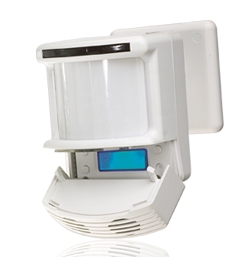Occupancy sensors – why should you
use any of these?
 There are a number of reasons why you would want to integrate occupancy sensors with your CCTV system. In some cases you could use them to trigger a remote recording device such as your DVR, which would save on image storage space.
There are a number of reasons why you would want to integrate occupancy sensors with your CCTV system. In some cases you could use them to trigger a remote recording device such as your DVR, which would save on image storage space.
They can also be used to turn lights on or off in areas, which is valuable with CCTV applications as in the event of a break in or other incident, triggering the lighting will enable to cameras to obtain an excellent shot of the event. In most cases occupancy sensors are used to facilitate energy savings through switching various appliances off when there are no people around.
Different types of occupancy sensors
There are four main types of occupancy sensors, each with its own features and benefits which makes them more or less suitable for specific applications. These are motion sensors, PIR, ultrasonic and dual technology which is a combination of PIR and ultrasonic.
Motion sesors – most widely used in CCTV apps
One fairly common occupancy sensor used in CCTV applications is the motion sensor. This type of sensor effectively monitors the camera feed so that the operator doesn’t have to. These can also be referred to as video motion detectors, or VMD’s, and are available in a range of specifications and sizes, from single camera VMD’s which analyses the video feed for movement and sounds an alarm if motion is detected, up to much more sophisticated units which can be used to trigger recording on the VCR or DVR or to switch on lights or sound alarms.
The higher end of the market also sees the integration of features such as flexible monitoring, where different parts of the image can be set to different levels of sensitivity using an on screen display. This can be useful if, for example, you want to monitor movement on a driveway but do not want people walking past the end of the driveway or cars passing by to set off the detector.
PIR sensors
A Passive Infrared (PIR) sensor measures infrared light bouncing back from objects in its field of view. Infrared light is invisible to the human eye, but can be monitored by electrical units for exactly this type of application. PIR detects any changes to the ‘normal’ state and can be used to activate pretty much any electrical equipment or to sound an alarm.
Most commonly these are used with office alarm systems, automatic lighting systems and with CCTV systems to activate video recording.
One main advantage of using PIR is that it is just as effective in the dark as it is in daylight, so can be a good solution to night time surveillance when used in conjunction with an infra red camera. However, the user needs to be careful where to position the unit, as nearby glass, changes in temperature and direct sunlight can all cause false alarms to be raised.
Ultrasonic sensors
Ultrasonic sensors are less widely used, but are certainly a technology which is gaining in popularity and should be considered when looking for occupancy sensor solutions. These work on a similar principle to sonar or radar, in that the electronics listen for echoes of a sound they produce to sense how far away an object is.
In terms of security systems, the ultrasonic detector is not so much mapping the area, as looking for changes to the map. If a foreign object enters the detection space then the unit will activate the appliances it is connected to, be this lights, a camera or an alarm. In addition to seeking new objects in the area, the ultrasonic detectors also listen for changes in the area. Sounds such as breaking glass, hammering or voices can be set to trigger the sensor, making them a valuable tool in both home and business security.
Dual technology – a combination of PIR and ultrasonic technology
The last type of occupancy sensor is the dual technology sensor. These combine the technology of the PIR sensor with that of an ultrasonic detector to create a system which is sensitive yet less likely to trigger false alarms.
Dual sensors are often used in hotel rooms or office buildings where, for energy saving reasons, the lights only come on when someone is in the area. By combining PIR and ultrasonic, the unit will use a combination of movement, body heat and sound to recognise when someone is in the area, thereby lessening the chance of the lights switching off unwontedly.
In terms of security, this technology offers an all round solution which can be tailored to the situation it is being placed in. The sensitivity of both detectors can be adjusted and reset to avoid passing trains or next doors cat setting the alarm off, resulting in a more reliable and less fallible occupancy sensing system.
